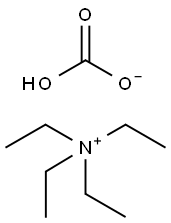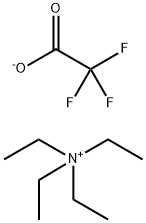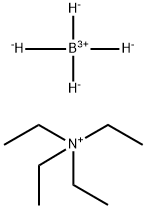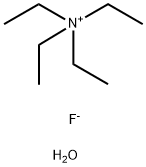Tetraethylammonium hexafluorophosphate
- CAS NO.:429-07-2
- Empirical Formula: C8H20F6NP
- Molecular Weight: 275.22
- MDL number: MFCD00043179
- EINECS: 207-056-7
- SAFETY DATA SHEET (SDS)
- Update Date: 2024-11-14 14:09:35

What is Tetraethylammonium hexafluorophosphate?
Chemical properties
Colorless crystal
The Uses of Tetraethylammonium hexafluorophosphate
Maintenance of fluoride atmospheres; preparation of bactericides and fungicides.
The Uses of Tetraethylammonium hexafluorophosphate
It is used extensively in electrolytes for electrochemical synthesis.
What are the applications of Application
Tetraethylammonium hexafluorophosphate is used extensively in electrolytes for electrochemical synthesis
General Description
Visit our Sensor Applications portal to learn more.
Hazard
Irritant to skin.
Purification Methods
Dissolve the salt (0.8g) in hot H2O (3.3mL) and cool to crystallise. Yield of prisms is 0.5g. Its solubility in H2O is 8.1g/L at 19o [Lange & Müller Chem Ber 63 1067 1930]. [Beilstein 4 III 199.]
Properties of Tetraethylammonium hexafluorophosphate
| Melting point: | ≥300 °C (lit.) |
| solubility | acetonitrile: 0.1 g/mL, clear, colorless |
| form | Crystalline |
| Water Solubility | Soluble in water, alcohol, and acetonitrile. |
| Sensitive | Hygroscopic |
| BRN | 3748868 |
Safety information for Tetraethylammonium hexafluorophosphate
| Signal word | Warning |
| Pictogram(s) |
 Exclamation Mark Irritant GHS07 |
| GHS Hazard Statements |
H315:Skin corrosion/irritation H319:Serious eye damage/eye irritation H335:Specific target organ toxicity, single exposure;Respiratory tract irritation |
| Precautionary Statement Codes |
P261:Avoid breathing dust/fume/gas/mist/vapours/spray. P264:Wash hands thoroughly after handling. P264:Wash skin thouroughly after handling. P271:Use only outdoors or in a well-ventilated area. P280:Wear protective gloves/protective clothing/eye protection/face protection. P302+P352:IF ON SKIN: wash with plenty of soap and water. P305+P351+P338:IF IN EYES: Rinse cautiously with water for several minutes. Remove contact lenses, if present and easy to do. Continuerinsing. |
Computed Descriptors for Tetraethylammonium hexafluorophosphate
New Products
(S)-3-Aminobutanenitrile hydrochloride 4-Methylphenylacetic acid N-Boc-D-alaninol N-BOC-D/L-ALANINOL Tert-butyl bis(2-chloroethyl)carbamate 3-Morpholino-1-(4-nitrophenyl)-5,6-dihydropyridin- 2(1H)-one Furan-2,5-Dicarboxylic Acid Tropic acid 1-Bromo-3,5-Di-Tert-Butylbenzene S-2-CHLORO PROPIONIC ACID ETHYL ISOCYANOACETATE 2-Bromo-1,3-Bis(Dimethylamino)Trimethinium Hexafluorophosphate 4-IODO BENZOIC ACID 3-NITRO-2-METHYL ANILINE 1-(2,4-DICHLOROPHENYL) ETHANAMINE (2-Hydroxyphenyl)acetonitrile 4-Bromopyrazole 2-(Cyanocyclohexyl)acetic acid 4-methoxy-3,5-dinitropyridine 1-(4-(aminomethyl)benzyl)urea hydrochloride 2-aminopropyl benzoate hydrochloride diethyl 2-(2-((tertbutoxycarbonyl)amino) ethyl)malonate tert-butyl 4- (ureidomethyl)benzylcarbamate Ethyl-2-chloro((4-methoxyphenyl)hydrazono)acetateRelated products of tetrahydrofuran








You may like
-
 Tetraethylammonium hexafluorophosphate CAS 429-07-2View Details
Tetraethylammonium hexafluorophosphate CAS 429-07-2View Details
429-07-2 -
 Tetraethylammonium hexafluorophosphate CAS 429-07-2View Details
Tetraethylammonium hexafluorophosphate CAS 429-07-2View Details
429-07-2 -
 Tetraethylammonium hexafluorophosphate CAS 429-07-2View Details
Tetraethylammonium hexafluorophosphate CAS 429-07-2View Details
429-07-2 -
 Tetraethylammonium hexafluorophosphate CAS 429-07-2View Details
Tetraethylammonium hexafluorophosphate CAS 429-07-2View Details
429-07-2 -
 1975-50-4 98%View Details
1975-50-4 98%View Details
1975-50-4 -
 2-HYDROXY BENZYL ALCOHOL 98%View Details
2-HYDROXY BENZYL ALCOHOL 98%View Details
90-01-7 -
 14714-50-2 (2-Hydroxyphenyl)acetonitrile 98+View Details
14714-50-2 (2-Hydroxyphenyl)acetonitrile 98+View Details
14714-50-2 -
 118753-70-1 98+View Details
118753-70-1 98+View Details
118753-70-1
Statement: All products displayed on this website are only used for non medical purposes such as industrial applications or scientific research, and cannot be used for clinical diagnosis or treatment of humans or animals. They are not medicinal or edible.